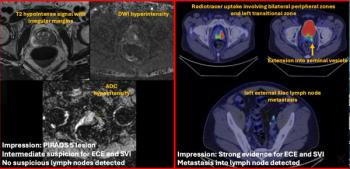For patients with high-grade gliomas (HGGs), advanced magnetic resonance imaging (MRI) neuroimaging may have a significant impact.
In a prospective study, recently published in the American Journal of Roentgenology, reviewed findings from neuro-oncologist surveys taken prior to and after 70 MRI neuroimaging sessions for a total of 63 patients with WHO grade 4 diffuse gliomas treated with chemoradiation. All patients had magnetic resonance spectroscopy (MRS), dynamic contrast-enhanced (DCE) MRI, dynamic susceptibility contrast (DSC) perfusion imaging, and 28 cases involved the use of arterial spin labeling (ASL) perfusion sequences, according to the study.
Advanced MRI neuroimaging would have led to changes in patient management in 31 of 70 cases (44 percent), according to the study authors.1 This represents a greater than fivefold increase for changes in patient management in comparison to an 8.5 percent estimate from a previous 2012 study evaluating the use of MRI perfusion imaging for the management of patients with brain tumors.2
The researchers noted that management plan changes would have involved changes in chemotherapeutic modalities in 12 of 19 cases, participation in clinical trials in four of eight cases and surgical intervention in four of eight cases.1
“The high frequency of management changes observed in the present study supports a role for advanced neuroimaging in the evaluation of patients with treated HGGs and equivocal findings on conventional MRI,” wrote Samir A. Dagher, M.D., who is affiliated with the Department of Neuroradiology at the University of Texas MD Anderson Cancer Center in Houston, and colleagues.
The researchers noted that advanced MRI neuroimaging revealed glioma progression in 37 percent of cases, the impact of treatment in 46 percent of cases and mixed findings in 17 percent of the episodes of care (EOCs). After retrospective reclassification of the cases involving mixed findings, the study authors noted glioma progression in 50 percent of cases and treatment effects in 50 percent of cases.1
Three Key Takeaways
1. Significant impact on patient management. Advanced MRI neuroimaging techniques, such as magnetic resonance spectroscopy (MRS), dynamic contrast-enhanced (DCE) MRI, and perfusion imaging, led to changes in patient management in 44 percent of the cases studied, which is a substantial increase compared to previous studies.
2. Detection of glioma progression and treatment effects. The advanced MRI techniques helped identify glioma progression in 37 percent of cases and assessed the impact of treatment in 46 percent of cases. After reclassification of mixed findings, the study showed a 50 percent rate of glioma progression and a 50 percent rate of treatment effects.
3. Utility across different glioma types. Neuro-oncologists found advanced MRI neuroimaging helpful in 93% of the episodes of care (EOCs), with no significant difference in utility between IDH-wildtype and IDH-mutant gliomas, although a higher percentage of progression was observed in IDH-wildtype cases.
While advanced MRI neuroimaging was deemed “helpful” by neuro-oncologists in 93 percent of the EOCs, the researchers said there were no significant differences in assessing the utility of advanced MRI techniques between cases involving IDH-wildtype gliomas (93 percent finding it helpful) and patients with IDH-mutant tumors (90 percent finding it helpful). The study authors noted a higher percentage of glioma progression for patients with IDH-wildtype gliomas (34/60 patients, 57 percent) in comparison to cases involving IDH-mutant tumors (4/10, 40 percent), but this difference wasn’t statistically significant.1
“Future work could focus on further refining the subpopulation of patients who would most strongly benefit from advanced neuroimaging, determining the timing and frequency of advanced neuroimaging examinations, as well as understanding the contexts in which the various advanced neuroimaging techniques should be performed,” posited Dagher and colleagues.
(Editor’s note: For related content, see “MRI Findings Show Vorasidenib More Than Doubles Progression-Free Survival in Patients with Grade 2 IDH Gliomas,” “FDA Clears Updated Software for Faster Low-Field MRI Brain Scans” and “Emerging PET Agent Gets FDA Fast Track Designation for Glioma Imaging.”)
In regard to study limitations, the authors noted the small sample size and drawing the data from a single tertiary center limits extrapolation of the study findings to broader patient populations. The researchers also noted the lack of longitudinal follow-up and the use of retrospective reclassification of neuroimaging when initial imaging interpretation suggested mixed findings.
References
1. Dagher SA, Liu HL, Ozkara BB, et al. The impact of MRI-based advanced neuroimaging on neurooncologists’ clinical decision-making in patients with posttreatment high-grade glioma: a prospective survey-based study. AJR Am J Roentgenol. 2024 Aug 14. doi: 10.2214/AJR.24.31595. Online ahead of print.
2. Geer CP, Simonds J, Anvery A, et al. Does MR perfusion imaging impact management decisions for patients with brain tumors? Am J Neuroradiol. 2012;33(3):556-562.





























